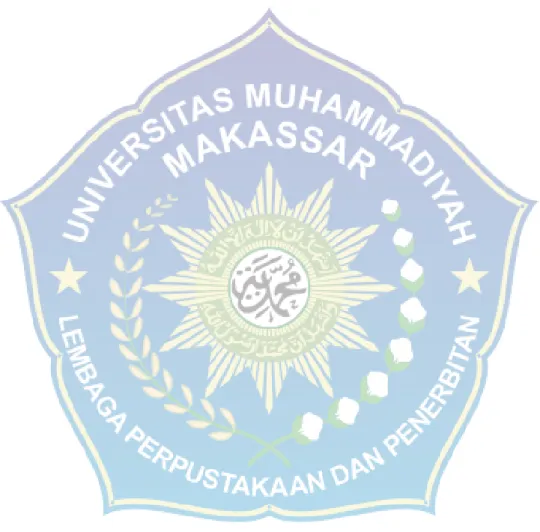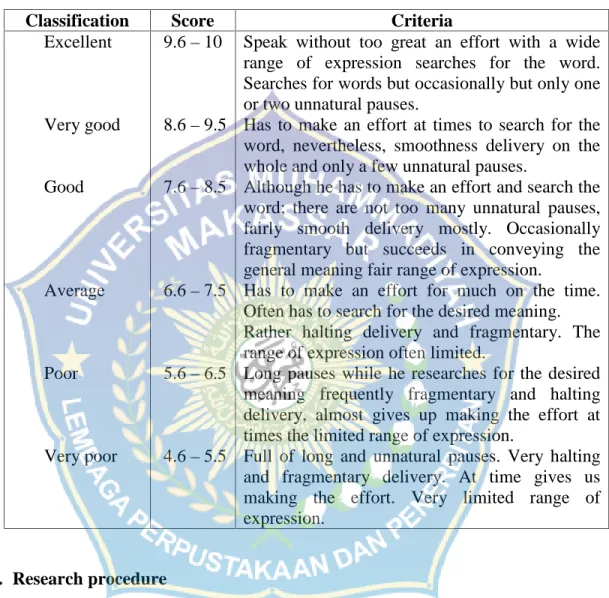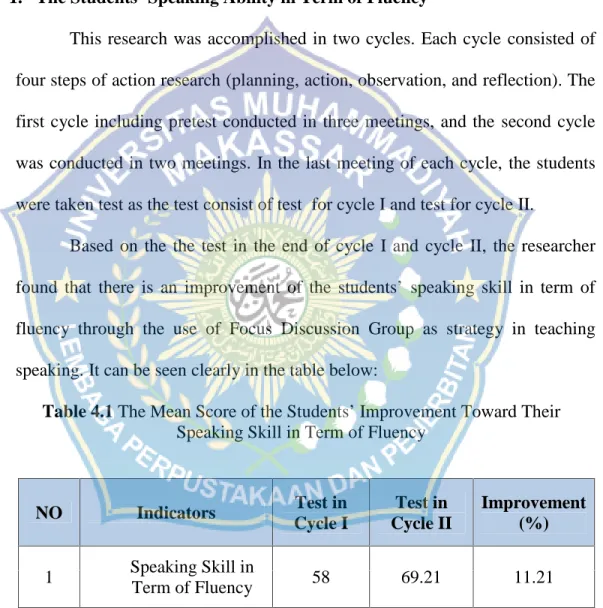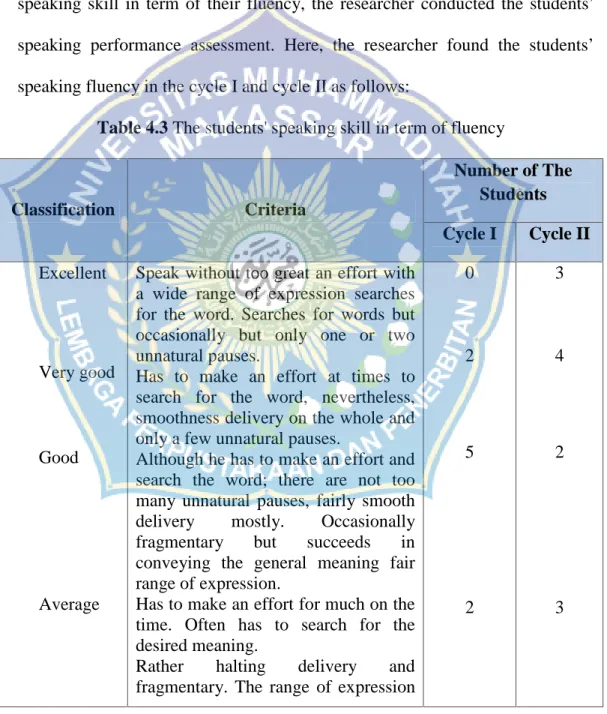Judul Skripsi : Using focus group discussion technique to improve students' speaking skills at SMK Ahlu Suffah. Using Focus Group Discussion Technique to Improve Students' Speaking Skills at SMK Ahlu Suffah Muhammadiyah Bantaeng.
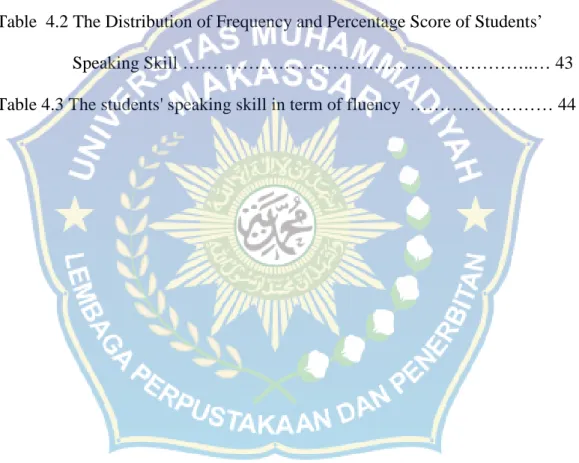
INTRODUCTION
- Background of the Research
- Problem Statements
- Objectives of the Research
- Siginifican of the Research
- Scope of the Research
The quantitative data is analyzed in the score of the students' speaking performance in terms of fluency. 2013).The effectiveness of role playing in improving the speaking skills of the learners in a large classroom: An investigation of tertiary level students.
REVIEW OF LITERATURE
Previous Research
So the students have the motivation and want to know how the focus group discussion should go in the learning process. And all students achieved a high score in teaching the learning process through focus group discussions.
The Nature of Speaking Skill
Syntactic complexity can be measured according to the number of direct components of the syntactic structure. In the context of synergetic linguistics, it is also related to position (within the parent constituent) and length (measured by the number of terminal nodes.
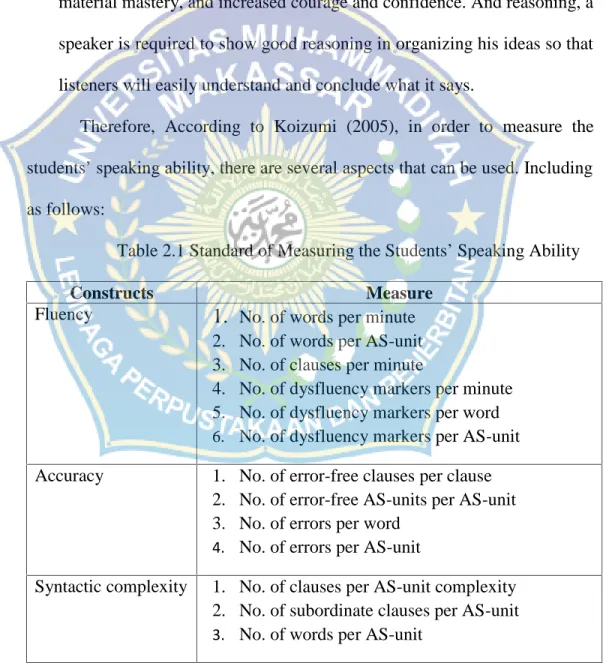
Focus Group Discussion
Focus Group Discussion (FGD) is a group thinking that allows individual ideas or opinions to also voice their responses on the opinions of others. Focus group discussion (FGD) consists of people with certain heterogeneous characteristics and similar levels of understanding of a topic. 2001:20) said that given the heterogeneity of the group, the depth of information to be obtained from the focus group. Litosseliti (2013:32) suggested that the group should consist of between six and ten participants. 2011:26) believed that they and eight participants as focus group discussion.
The small focus group is chosen to encourage participants to elaborate on the topic to be discussed. The quality of the questions asked in a focus group can greatly influence the type of information obtained. Before starting a focus group discussion, the facilitator should obtain background information such as their age, basic knowledge of the topic, skills and other relevant information.
A focus group discussion begins with an introduction that explains the purpose and topic of the discussion. According to Masedah, there are some advantages that can be gained from using focus group discussions (FGDs).
Conceptual Framework
The use of FGD is expected to improve students' speaking ability in terms of fluency. Qualitative data analyzed from quantitative to describe the improvement of students' speaking ability in terms of fluency. The management function in II. cycle is to evaluate the effectiveness of FGDs in improving students' speaking ability in terms of fluency.
The aim of the actions was to increase the students' speaking skills, especially in terms of fluency. This means that students' speaking skill in terms of fluency is improved by using focus group discussion as a strategy in teaching speaking. It was shown that the results of the students' test at the end of II.
This could be proven by some indicators that showed the improvement in the students' speaking ability. Rusydina (2016) The effectiveness of brain mapping and group discussion to increase the students' speaking ability (a quasi-experimental research of the eighth grade students of SMP Negeri 1 Bawen in the academic year of 2015/2016).
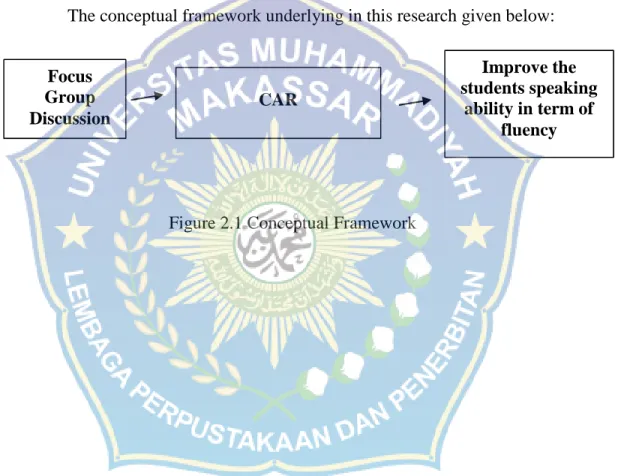
Population and Sample
Technique of Data Collection
This researcher got the data from teacher and students during teaching-learning process activity (1) Students is a learner, in this research students are the important object as a source of the data. 2) Teacher as collaborator, the collaborator assists the researcher in carrying out the action research. The data related to students' speaking skills were obtained by conducting FGD technique and testing the students' speaking performance in each cycle. The test in cycle I was intended to assess the students' speaking ability which was taken in the first meeting before the researcher conducted the research by applying FGD in the classroom.
The tests took the form of an oral test to measure the speaking skills of the students in terms of accuracy. Speak effortlessly with a wide range of phrase searches for the word. Has to struggle to find the word at times, but still smooth playback overall and only a few unnatural pauses.
Although he has to make an effort and search for a word; there aren't too many unnatural pauses, the delivery is fairly smooth for the most part. Long pauses while he searches for the desired meaning, often fragmentary and halting delivery, he almost gives up the effort to reach a sometimes limited range of expression.
Research Procedure
Based on the test at the end of cycle I and cycle II, the researcher found that there is an improvement in students' speaking ability in terms of fluency through the use of Focus Discussion Group as a strategy in teaching speaking. After reflecting cycle I and implementing a better application of FGD in cycle II, the researcher found that there is an improvement in students' speaking ability in terms of their fluency using FGD as a strategy in teaching speaking. The researcher concluded that using FGD in teaching speaking can improve students.
It indicated that there is an improvement in the speaking skills of the students in terms of fluency through the use of focus group discussions as a strategy in learning to speak. In addition, Hasan (2015) explained that students' speaking skills can be increased through image and group discussion techniques. Based on the results of the study, it could be concluded that using focus group discussions as a strategy in teaching speaking skills in terms of fluency can improve students' speaking skills.
The average grade of students in the first cycle is 58 and in the second cycle with an average score of 69.21. The effectiveness of mind maps and group discussions to increase students' speaking ability (quasi-experimental research on eighth grade students of SMP Negeri 1 Bawen in the academic year 2015/2016).
Techniques of Analysing the Data
FINDINGS AND DISCUSSION
Findings
In the last meeting of each cycle, the students were tested, as the test consists of a test for cycle I and a test for cycle II. Based on Table 4.1, it can be known that after giving a student's test, the researcher found that the average score of the students in cycle I is 58 and improved. From the previously mentioned data in the students' average scores, the researcher also found the distribution of frequency and percentage scores in relation to their speaking skills.
According to table 4.2, none of the students achieved an excellent or very good result in the 1st cycle, but 6 students achieved a good result and 3 students an average grade. Then in II. cycle the ranking result of students showed improvement where 3 students got very good result and 6 students got good result and none of them got excellent result. Table 4.3 shows that out of 19 students practicing their English speaking from the class, in the first cycle none of the students got an excellent score for their speaking performance according to their fluency, but the result in II. cycle, where 3 students achieved an excellent speech performance rating in terms of fluency.
Then, in cycle I, there are 2 students who got very good results and 5 students got good results, 2 students got average, 3 students got poor results and 7 students got very poor performance results their speech. Here are 4 students who performed very well, 2 students performed well, 3 students average good, 5 poor and the number of students is very poor is reduced to 2 students.
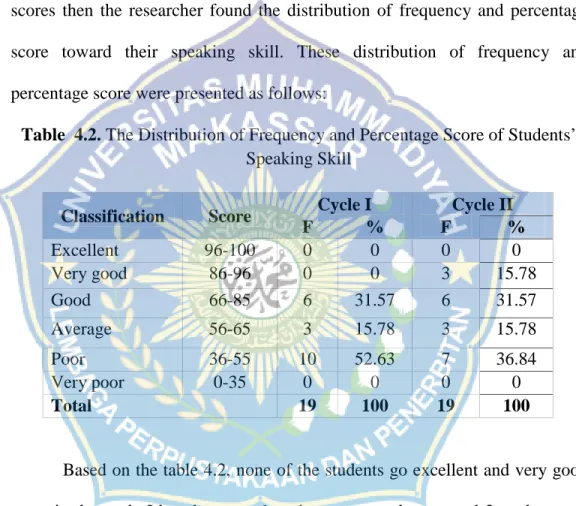
Discussion
The researcher focused more on how to motivate students to speak well. The opening was held to greet students, check attendance and motivate students to join the teaching and learning process. We also drew students' attention to the material for checking students' understanding before starting teaching and learning.
There were improvements in students' fluency in terms of fluency using FGD, especially for the students of SMA Ahlu Suffah Muhammadiyah in the first cycle and second cycle. The test in the first cycle showed that the result of the test showed that none of the students got an excellent score in speaking in terms of their fluency, but there are 3 students who got an excellent score in speaking in terms of their fluency. fluency in the second cycle. These findings are in close agreement with some previous research findings that support these findings, including Rusydina (2016) who found that group discussion is the method that requires the students to be active in order to talk more.
And finally, Sasmita and Gurning (2012) found that focus group discussion is a good method that can invite the students to be active, have good motivation and engage in a lot of activity. First of all, teachers should use FGD as an alternative strategy when teaching speaking. It should be creative to use it to make the students more active and interested in teaching the learning process.
CONCLUSSION AND SUGGESTION
Conclusion
This can be seen from the results of the test at the end of cycle I and cycle II.
Suggestion
Hasan (2015) The use of picture and group discussions to increase speaking skills (action research in the classroom of first grade students an academic year of. Mulyo (2015) The use of spontaneous group discussions to improve students' ability to speak about the eleventh year of SMK Diponegoro salatiga to be improved in the student academic year a classroom action research). Improving speaking skills through small group conversations (A classroom action study for third grade students of Pancasila salatiga Secondary School in the academic year 2015/2016).
Sasmita dan Gurning (2012) Meningkatkan kinerja siswa dalam menulis. Menceritakan kembali teks melalui diskusi kelompok terfokus (FGD). Siswa dapat menunjukkan perilaku santun ketika melakukan komunikasi interpersonal dengan guru dan teman. Siswa dapat mengidentifikasi tujuan teks frase untuk mengungkapkan pendapat, pikiran dan tanggapannya dengan benar.
Siswa dapat mengidentifikasi struktur teks ungkapan yang mengungkapkan pikiran dan pendapat beserta jawabannya dengan benar. Siswa dapat mengidentifikasi unsur kebahasaan ungkapan mengungkapkan pikiran dan pendapat serta jawaban yang benar. Siswa dapat menyusun teks lisan untuk menyatakan dan menanggapi ungkapan mengungkapkan pikiran dan pendapat, dengan memperhatikan fungsi sosial, struktur teks, dan unsur kebahasaan, secara akurat dan sesuai konteks.
Siswa dapat menghasilkan teks tertulis untuk mengungkapkan dan menanggapi ungkapan mengungkapkan pikiran dan pendapat, dengan memperhatikan fungsi sosial, struktur teks, dan unsur kebahasaan, secara akurat dan sesuai konteks.
